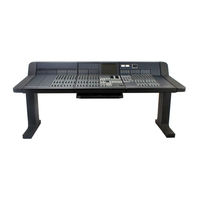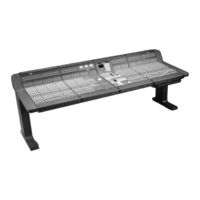Euphonix MixView CS2000 mixing console Manuals
Manuals and User Guides for Euphonix MixView CS2000 mixing console. We have 3 Euphonix MixView CS2000 mixing console manuals available for free PDF download: Operation Manual, Software Manual
Euphonix MixView CS2000 Operation Manual (324 pages)
digitally controlled analog audio mixing systems
Brand: Euphonix
|
Category: Music Mixer
|
Size: 6 MB
Table of Contents
-
-
-
The Patchbay19
-
The DSC22
-
This Manual23
-
-
-
-
Status Bar46
-
Projects50
-
New Project51
-
Copy Project52
-
-
Titles53
-
Mixes58
-
-
-
Auto-Backup69
-
-
Meters76
-
Equalizers81
-
-
Clear Block91
-
Copy Block91
-
Copy Channel91
-
Block Copy93
-
Add EQ94
-
Sound94
-
-
Overview99
-
Aux Modes99
-
Exercise 599
-
Exercise 6101
-
Exercise 7103
-
Mono Pan Mode103
-
Mono Mode104
-
-
Exercise 8105
-
SOLO AFL and PFL107
-
AFL Mode107
-
Kill solo Safe108
-
PFL Mode108
-
-
Direct Outputs109
-
The Combiner111
-
-
Talkback120
-
Oscillator120
-
D Monitor/Phones123
-
-
Monitor Automute124
-
Monitor Link124
-
Cue Points134
-
-
Cycling139
-
Fader Names140
-
-
-
Half-Normalling144
-
Patchbay Layout146
-
User Connections147
-
-
User Connections151
-
-
-
-
-
Motors ON/OFF159
-
Touch ON/OFF159
-
Release ON/OFF160
-
-
-
Overview165
-
Setup165
-
New MIX166
-
The MIX Snapshot167
-
Naming a New MIX167
-
New MIX Dialog167
-
-
MIX Comments168
-
MIX Screen168
-
-
MIX Menu168
-
-
-
The Punch Key171
-
-
Recording Moves172
-
Fader Moves172
-
Null Lights172
-
Punch out172
-
Initial Pass172
-
-
Pan Move172
-
Mute Move172
-
-
Pass Control173
-
Screen Anatomy173
-
Pass Tree173
-
Event Count173
-
Edit173
-
Cues173
-
Snaps173
-
Aux A-D173
-
Pan Bal173
-
ON (Mute)174
-
-
-
Clearing Passes174
-
Packing Passes174
-
View Menu175
-
View Scale175
-
Full/Half Screen175
-
Zoom Factor176
-
-
Trim Mode176
-
-
ABS Win Mode178
-
ABS Wout Mode178
-
ABS Wthr Mode179
-
-
Punch Menu179
-
Exercise 1181
-
-
Punching-In182
-
-
-
Set Mode183
-
Dyn Mode183
-
Isolate Mode183
-
Safe Modes183
-
Suppression Menu184
-
-
Automated EQ185
-
-
Edit Operations186
-
-
Edit Template188
-
Edit Region188
-
On-The-Fly189
-
Offline Trim189
-
Pass Join190
-
Example190
-
-
Exercise 2190
-
Join Template191
-
Import MIX194
-
Group Coalesce195
-
-
Event Parameters196
-
Event Parameters197
-
CHAN Parameter198
-
Timecode Editing199
-
Event Mode199
-
-
-
-
Overview203
-
Exercise 1203
-
Creating a Group203
-
Deleting Groups211
-
Group solo Modes212
-
-
-
Overview214
-
-
-
Features219
-
ES108A Wiring220
-
-
Dynamics Screen241
-
Key Inputs252
-
Filters253
-
Filter Types254
-
-
Mixview Display261
-
-
-
Overview267
-
-
Chassis269
-
Power Supply269
-
Quad Bus Cards269
-
Interconnections270
-
Bus Inserts270
-
-
-
Direct Outputs274
-
Cube Metering275
-
-
Define Bus Types276
-
-
Defining Buses277
-
Exercise 1277
-
Cube Aux Masters278
-
Stereo Aux Sends278
-
Naming Aux Sends278
-
Buss Kill279
-
Aux Copy280
-
Bus Iso280
-
-
Pan Bus Masters280
-
Bus Kill280
-
-
-
-
-
Overview283
-
Exercise 1284
-
Selecting a Bus285
-
Next Block285
-
-
Using the Panner286
-
-
Exercise 2289
-
Exercise 3290
-
Preset Library291
-
Standard Formats291
-
Custom Formats292
-
-
-
-
Overview295
-
Program Changes295
-
-
Appendices
303-
Front310
-
Rear310
-
Outside310
-
Surface310
-
Model311
-
Cs3000-2-40311
-
Cs3000-3-72311
-
Cs3000-4-104311
Advertisement
Euphonix MixView CS2000 Software Manual (85 pages)
MixView v3.0
Brand: Euphonix
|
Category: Music Mixer
|
Size: 2 MB
Table of Contents
-
-
Punch Menu13
-
Pass Join14
-
Exercise 115
-
Exercise 220
-
-
-
Overview23
-
Chassis25
-
Power Supply25
-
Bus Inserts26
-
Exercise 133
-
-
-
Overview37
-
-
-
Overview53
-
Aux Modes53
-
Exercise 153
-
Exercise 255
-
Exercise 357
-
Exercise 459
-
Meter Modes62
-
-
-
Overview73
-
Euphonix MixView CS2000 Software Manual (26 pages)
MixView 3.2
Brand: Euphonix
|
Category: Music Mixer
|
Size: 0 MB
Table of Contents
-
-
-
Loop Mode18
-
Build Mode19
-
A Note on19
-
-
Track Panner25
Advertisement


